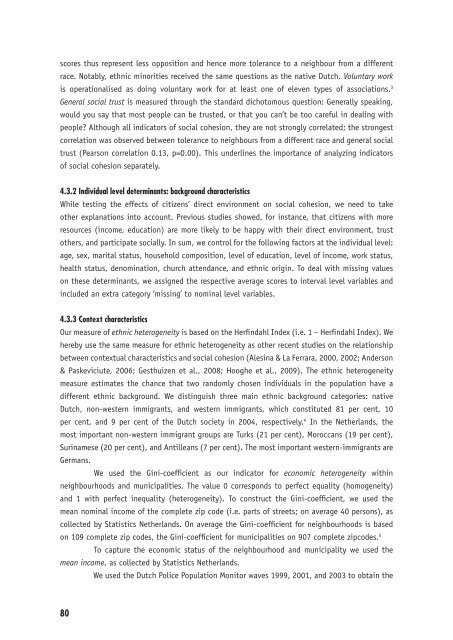Ethnic Hostility among Ethnic Majority and Minority Groups
Ethnic Hostility among Ethnic Majority and Minority Groups
Ethnic Hostility among Ethnic Majority and Minority Groups
Create successful ePaper yourself
Turn your PDF publications into a flip-book with our unique Google optimized e-Paper software.
scores thus represent less opposition <strong>and</strong> hence more tolerance to a neighbour from a different<br />
race. Notably, ethnic minorities received the same questions as the native Dutch. Voluntary work<br />
is operationalised as doing voluntary work for at least one of eleven types of associations. 3<br />
General social trust is measured through the st<strong>and</strong>ard dichotomous question: Generally speaking,<br />
would you say that most people can be trusted, or that you can’t be too careful in dealing with<br />
people? Although all indicators of social cohesion, they are not strongly correlated; the strongest<br />
correlation was observed between tolerance to neighbours from a different race <strong>and</strong> general social<br />
trust (Pearson correlation 0.13, p=0.00). This underlines the importance of analyzing indicators<br />
of social cohesion separately.<br />
4.3.2 Individual level determinants: background characteristics<br />
While testing the effects of citizens’ direct environment on social cohesion, we need to take<br />
other explanations into account. Previous studies showed, for instance, that citizens with more<br />
resources (income, education) are more likely to be happy with their direct environment, trust<br />
others, <strong>and</strong> participate socially. In sum, we control for the following factors at the individual level:<br />
age, sex, marital status, household composition, level of education, level of income, work status,<br />
health status, denomination, church attendance, <strong>and</strong> ethnic origin. To deal with missing values<br />
on these determinants, we assigned the respective average scores to interval level variables <strong>and</strong><br />
included an extra category ‘missing’ to nominal level variables.<br />
4.3.3 Context characteristics<br />
Our measure of ethnic heterogeneity is based on the Herfi ndahl Index (i.e. 1 – Herfi ndahl Index). We<br />
hereby use the same measure for ethnic heterogeneity as other recent studies on the relationship<br />
between contextual characteristics <strong>and</strong> social cohesion (Alesina & La Ferrara, 2000, 2002; Anderson<br />
& Paskeviciute, 2006; Gesthuizen et al., 2008; Hooghe et al., 2009). The ethnic heterogeneity<br />
measure estimates the chance that two r<strong>and</strong>omly chosen individuals in the population have a<br />
different ethnic background. We distinguish three main ethnic background categories: native<br />
Dutch, non-western immigrants, <strong>and</strong> western immigrants, which constituted 81 per cent, 10<br />
per cent, <strong>and</strong> 9 per cent of the Dutch society in 2004, respectively. 4 In the Netherl<strong>and</strong>s, the<br />
most important non-western immigrant groups are Turks (21 per cent), Moroccans (19 per cent),<br />
Surinamese (20 per cent), <strong>and</strong> Antilleans (7 per cent). The most important western-immigrants are<br />
Germans.<br />
We used the Gini-coeffi cient as our indicator for economic heterogeneity within<br />
neighbourhoods <strong>and</strong> municipalities. The value 0 corresponds to perfect equality (homogeneity)<br />
<strong>and</strong> 1 with perfect inequality (heterogeneity). To construct the Gini-coeffi cient, we used the<br />
mean nominal income of the complete zip code (i.e. parts of streets; on average 40 persons), as<br />
collected by Statistics Netherl<strong>and</strong>s. On average the Gini-coeffi cient for neighbourhoods is based<br />
on 109 complete zip codes, the Gini-coeffi cient for municipalities on 907 complete zipcodes. 5<br />
To capture the economic status of the neighbourhood <strong>and</strong> municipality we used the<br />
mean income, as collected by Statistics Netherl<strong>and</strong>s.<br />
We used the Dutch Police Population Monitor waves 1999, 2001, <strong>and</strong> 2003 to obtain the<br />
80












